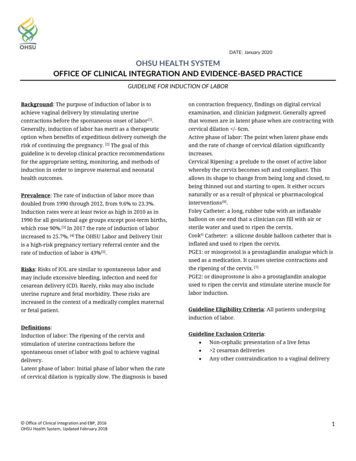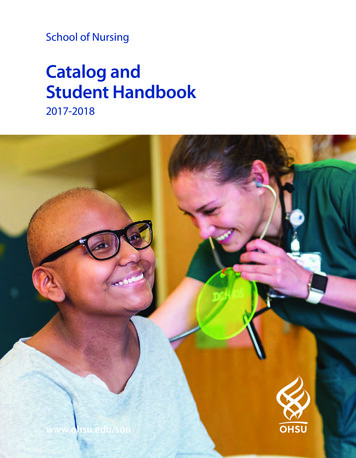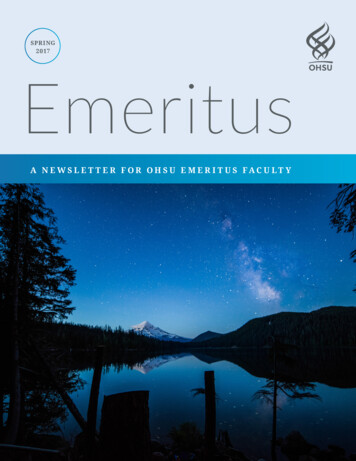
Transcription
DATE: January 2020OHSU HEALTH SYSTEMOFFICE OF CLINICAL INTEGRATION AND EVIDENCE-BASED PRACTICEGUIDELINE FOR INDUCTION OF LABORBackground: The purpose of induction of labor is toon contraction frequency, findings on digital cervicalachieve vaginal delivery by stimulating uterineexamination, and clinician judgment. Generally agreedcontractions before the spontaneous onset of labor[1].that women are in latent phase when are contracting withGenerally, induction of labor has merit as a therapeuticcervical dilation /- 6cm.option when benefits of expeditious delivery outweigh theActive phase of labor: The point when latent phase endsrisk of continuing the pregnancy.and the rate of change of cervical dilation significantly[2]The goal of thisguideline is to develop clinical practice recommendationsincreases.for the appropriate setting, monitoring, and methods ofCervical Ripening: a prelude to the onset of active laborinduction in order to improve maternal and neonatalwhereby the cervix becomes soft and compliant. Thishealth outcomes.allows its shape to change from being long and closed, tobeing thinned out and starting to open. It either occursPrevalence: The rate of induction of labor more thannaturally or as a result of physical or pharmacologicaldoubled from 1990 through 2012, from 9.6% to 23.3%.interventions[6].Induction rates were at least twice as high in 2010 as inFoley Catheter: a long, rubber tube with an inflatable1990 for all gestational age groups except post-term births,balloon on one end that a clinician can fill with air orwhich rose 90%.[3] In 2017 the rate of induction of laborsterile water and used to ripen the cervix.increased to25.7%. [4] TheOHSU Labor and Delivery Unitis a high-risk pregnancy tertiary referral center and therate of induction of labor is43%[5].Cook Catheter: a silicone double balloon catheter that isinflated and used to ripen the cervix.PGE1: or misoprostol is a prostaglandin analogue which isused as a medication. It causes uterine contractions andRisks: Risks of IOL are similar to spontaneous labor andthe ripening of the cervix. [7]may include excessive bleeding, infection and need forPGE2: or dinoprostone is also a prostaglandin analoguecesarean delivery (CD). Rarely, risks may also includeused to ripen the cervix and stimulate uterine muscle foruterine rupture and fetal morbidity. These risks arelabor induction.increased in the context of a medically complex maternalor fetal patient.Guideline Eligibility Criteria: All patients undergoinginduction of labor.Definitions:Induction of labor: The ripening of the cervix andstimulation of uterine contractions before thespontaneous onset of labor with goal to achieve vaginaldelivery.Guideline Exclusion Criteria: Non-cephalic presentation of a live fetus 2 cesarean deliveries Any other contraindication to a vaginal deliveryLatent phase of labor: Initial phase of labor when the rateof cervical dilation is typically slow. The diagnosis is based Office of Clinical Integration and EBP, 2016OHSU Health System, Updated February 20181
DATE: January 2020Clinical Practice Recommendations:AssessmentThe Bishop score should be used to rate the readiness of the cervix of labor. With this scoring system, a number ranging from0-13 is given to rate the condition of the cervix. Cervical Ripening should be considered with a Bishop score of less than 6. –Strong Recommendation, Moderate Quality of Evidence [8]Induction of Labor Phase 1: Cervical RipeningOutpatient In low risk patients, outpatient cervical ripening with Foley Catheter may be considered. – ConditionalRecommendation, Low Quality Evidence [9, 10]Methods for Cervical Ripening: It is reasonable to offer membrane sweeping for cervical ripening, with the timing and frequency at the discretion ofthe provider and patient. – Strong Recommendation, High Quality Evidence [11, 12] Evidence was inconclusive for cervical ripening with castor oil or acupuncture. If patient is interested in thesemethods, risk/benefit discussion with provider should include dialogue of inconclusive evidence. – ConditionalRecommendation, Moderate Quality Evidence [13, 14] Sexual intercourse should not be routinely recommended solely for the purpose of cervical ripening. Inform patientthat in the evidence, sexual intercourse was not effective for this purpose. – Conditional Recommendation,Moderate Quality Evidence [15-17]InpatientMonitoring: For inpatient cervical ripening, fetal wellbeing should be assessed according to the pharmacologic agent used (seeTable 1). – Consensus StatementMethods for Cervical Ripening: Shared decision making should be used when choosing the method for cervical ripening. – StrongRecommendation, Very low Quality Evidence [18, 19] For inpatient cervical ripening, breast stimulation with a breast pump may be considered. – ConditionalRecommendation, Low Quality Evidence [20, 21]To assist patients and providers in choosing methods of cervical ripening, OHSU Health System has developed a tieredapproach in which the methods are separated by preferred and alternative methods. The preferred options are chosenbecause the evidence has shown them to be as efficacious and without an increased risk of adverse events, and more costeffective than the alternative methods [22-26]. The tiered approach allows the opportunity to offer other methods if apatient and provider prefer an alternative method. Varying levels of evidence support each method’s effectiveness andeach method has its own strengths and limitations. Preferred Options (see Table 1 for more details) includes:oMisoprostol Vaginal administration, 25µ misoprostol every four hours – Strong Recommendation, ModerateQuality Evidence[27] or Office of Clinical Integration and EBP, 2016OHSU Health System, Updated February 20182
DATE: January 2020 Oral administration, 50µ misoprostol every four hours – Strong Recommendation, Low QualityEvidence[23, 28] or Oral misoprostol stepwise regimen of 50µ then 100µ after four hours followed by another 100µ afterfour hours – Strong Recommendation, Very Low Quality Evidence [29, 30] For Induction termination or fetal demise 28 week size uterus refer to “Medical Induction for TOPProtocol” OHSU Clinical Guideline for alternative misoprostol dosing regimen.ORoooFoley catheter alone filled with 60mL of saline – Strong Recommendation, Low Quality Evidence [31-34]ORFoley catheter combined with any of the above misoprostol options – Strong Recommendation, ModerateQuality Evidence [33-38]Foley catheter filled with 60mL saline (or Cook Catheter) with concurrent oxytocin, start at 2 mu/min andincrease by 2 mu/min every 30 min until regular contraction pattern – Conditional Recommendation, VeryLow Quality Evidence [39-41] Preferred option for patients undergoing trial of labor after cesarean (TOLAC)Alternative Options (see Table 1 for more details) includes:oDinoprostone 10mg vaginal insert – Conditional Recommendation, Moderate Quality Evidence [23, 42, 43]oCook Catheter used per the manufacturer’s instructions – Conditional Recommendation, ModerateOR Quality Evidence [25, 44]Amniotomy, Oxytocin alone, Laminaria tent, and extra-amniotic saline infusion were not included in this evidenceappraisal and can be used at the discretion of the clinician. – Consensus StatementInduction of Labor Phase 2: Active LaborOxytocin: Once the cervix is ripened, it is reasonable to use either a lower dose oxytocin protocol (start at 2mU/min andincrease by 2 mu/min q 30 min) or higher dose oxytocin protocol (start at 4 mu/min and increase by 4 mu/min every30 minutes) for induction of labor. – Strong Recommendation, Moderate Quality Evidence [45, 46]Induction of Labor: Additional ConsiderationsNutrition and Hydration: Low risk patients for aspiration should have unrestricted oral intake of fluid during induction of labor. – StrongRecommendation, Moderate Quality Evidence[47] It is reasonable to offer intravenous D5NS/D5LR at the rate of 250mL/h during active labor in women undergoinginduction of labor, may improve outcomes such as shortened duration of labor and reduction in the incidence ofcesarean delivery.-Conditional Recommendation, Moderate Quality Evidence [47] Solid food intake was not included in this evidence appraisal and should be a discussion between patient, providerand anesthesia team. – Consensus StatementEpidural analgesia: Office of Clinical Integration and EBP, 2016OHSU Health System, Updated February 20183
DATE: January 2020 Provide patients in early labor (i.e., 5 cm dilation) the option of neuraxial analgesia on an individualized basis –Conditional Recommendation, Moderate Quality Evidence Do not withhold neuraxial analgesia on the basis of achieving an arbitrary cervical dilation – StrongRecommendation, Moderate Quality EvidenceContinuous labor support:Continuous support during labor may improve outcomes for women and infants, defined as support from nurse, midwife,doula, childbirth educator, family member, friend or spouse/partner. Outcome include increased spontaneous vaginal birth,shorter duration of labor, and decreased caesarean birth, instrumental vaginal birth, use of any analgesia, use of regionalanalgesia, low five-minute Apgar score and negative feelings about childbirth experiences. – Conditional Recommendation,Low Quality Evidence [12, 48]Failed Induction DefinitionIf the maternal and fetal status allow, cesarean deliveries for failed induction of labor in the latent phase can be avoided byallowing longer durations of the latent phase (up to 24 hours or longer) and requiring that oxytocin be administered for atleast 15 hours after membrane rupture before deeming the induction a failure. – Strong Recommendation, ModerateQuality Evidence [2, 49, 50] Office of Clinical Integration and EBP, 2016OHSU Health System, Updated February 20184
DATE: January 2020Table 1. Cervical Ripening OptionsInterventionDose, timing, and routeMonitoringSpecial ConsiderationsContraindicationsPreferred MethodsMisoprostolOption 1: Vaginal: 25 µ every 4 hours.Max 6 dosesOption 2: Oral: 50 µ every 4 hours. Max 6dosesOption 3: Oral Stepwise: begin with 50 µ,then continue with 100 µ every 4 hours.Max 6 total dosesContinuous electronic fetal heart rate monitoring (CEFM)and tocometry (TOCO) for at least 3 hours afteradministration depending on contraction patterns.- Consider stepwise dosing for patients with a BMIPatients with a uterine scar 30[51] or if patient is not responding to 50 µ every 4 More than 5 painfulhours.contractions in 10 min-For Induction termination/fetal demise 28 wk sizeuterus refer to “Medical Induction for TOP Protocol”OHSU Clinical Guideline.Foley Catheter plusmisoprostolFC: Saline information below, leave in upto 24hMiso: Option 1, 2 or 3 above for dosingCEFM and TOCO for at least 3 hours after administration-Consider step dosing for patients with a BMI 30[51] Uterine scaror if patient is not responding to 50 µ every 4 hours-Caution when used with low lying placentaFoley CatheterFill to 60 mL with saline and leave in forup to 24hCEFM and TOCO for at least 30 min post placementCaution when used with low lying placentaFoley Catheter plusoxytocinFC: Fill to 60 mL with salineOxytocin: Start at 2mU/min and increaseby 2 mu/min q 30 min)CEFM and TOCO-Preferred option for patients TOLAC-Use caution when patient has prolonged QTsyndrome-Caution when used with low lying placentaAlternative MethodsDinoprostoneInsert: 10 mgCEFM and TOCO continuously while in place and at leastfor 15 min after removalMay be less effective in patients with a BMI 30 [52]Patients with a parity 5Uterine scarMore than 5 painfulcontractions in 10 minCook CatheterUse per manufacturer’s instructions(Appendix A)CEFM and TOCO for at least 30 min post placementCaution when used with low lying placentaUse per manufacturer’sinstructions (Appendix A) Office of Clinical Integration and EBP, 2016OHSU Health System, Updated February 20185
DATE: January 2020Quality Measures: Length of time from induction start to delivery Overall vaginal delivery (VD) rate VD rate in first 24 hrs. after admission Chorioamnionitis rates Length of 2nd stage Cesarean delivery (CD) rates Unexpected newborn complications: SevereImplementation Plan: Outpatient ripening protocol to be developed during implementation. Breast stimulation protocol to be developed during implementation. Information on induction of labor and the various methods of cervical ripening and induction to beadded to OHSU sponsored birth classes When choosing pharmacologic agents for cervical ripening, providers should consider their institution’sformulary. Clinical decision aids and patient education materials to be developed during implementation Office of Clinical Integration and EBP, 2016OHSU Health System, Updated February 20186
DATE: January 16.17.18.19.20.21.ACOG Practice Bulletin No. 107: Induction of labor. Obstet Gynecol, 2009. 114(2 Pt 1):p. 386-97.Caughey, A.B., et al., Safe prevention of the primary cesarean delivery. Am J ObstetGynecol, 2014. 210(3): p. 179-93.Martin, J.A., et al., Births: final data for 2013. Natl Vital Stat Rep, 2015. 64(1): p. 1-65.Martin, J.A., et al., Births: Final Data for 2016. Natl Vital Stat Rep, 2018. 67(1): p. 1-55.Oregon Maternal Data Center 2019.(UK), N.C.C.f.W.s.a.C.s.H., Induction of Labour. RCOG Press. Vol. 70. 2008: RCOGPress.Goldberg, A.B., M.B. Greenberg, and P.D. Darney, Misoprostol and Pregnancy. NewEngland Journal of Medicine, 2001. 344(1): p. 38-47.Ezebialu, I.U., et al., Methods for assessing pre‐induction cervical ripening. CochraneDatabase of Systematic Reviews, 2015(6).Policiano C, P.M.M.D.C.N., Outpatient versus inpatient cervix priming with Foleycatheter: a randomized trial. European journal of obstetrics, gynecology, andreproductive biology, 2017. 210: p. 1-6.Kelly, A.J., Z. Alfirevic, and A. Ghosh, Outpatient versus inpatient induction of labourfor improving birth outcomes. Cochrane Database of Systematic Reviews, 2013(11): p.CD007372.Boulvain, M., C. Stan, and O. Irion, Membrane sweeping for induction of labour.Cochrane Database of Systematic Reviews, 2005(1): p. CD000451.Berghella, V. and D. Di Mascio, Evidence-based labor management: before labor (Part1). American Journal of Obstetrics & Gynecology MFM, 2020. 2(1): p. 100080.Smith, C.A., M. Armour, and H.G. Dahlen, Acupuncture or acupressure for induction oflabour. Cochrane Database of Systematic Reviews, 2017(10).Neri, I., et al., Castor oil for induction of labour: a retrospective study. Journal ofMaternal-Fetal & Neonatal Medicine, 2018. 31(16): p. 2105-2108.Omar, N.S., et al., Coitus to expedite the onset of labour: a randomised trial. Bjog, 2013.120(3): p. 338-45.Schaffir, J., Sexual Intercourse at Term and Onset of Labor. Obstetrics & Gynecology,2006. 107(6): p. 1310-1314.Tan, P.C., C.M. Yow, and S.Z. Omar, Effect of coital activity on onset of labor in womenscheduled for labor induction: a randomized controlled trial. Obstet Gynecol, 2007.110(4): p. 820-6.Shetty, A., et al., Women's perceptions, expectations and satisfaction with inducedlabour--a questionnaire-based study. 2005. 1(1): p. 56-61.Moore, J.E., et al., Moving toward patient-centered care: Women's decisions,perceptions, and experiences of the induction of labor process. 2014. 1(2): p. 138-46.Singh, N., et al., Breast stimulation in low-risk primigravidas at term: does it aid inspontaneous onset of labour and vaginal delivery? A pilot study. BioMed ResearchInternational, 2014. 2014: p. 695037.Kavanagh, J., A.J. Kelly, and J. Thomas, Breast stimulation for cervical ripening andinduction of labour. Cochrane Database of Systematic Reviews, 2005(3): p. CD003392. Office of Clinical Integration and EBP, 2016OHSU Health System, Updated February 20187
DATE: January 7.38.39.Hofmeyr, G.J., A.M. Gulmezoglu, and C. Pileggi, Vaginal misoprostol for cervicalripening and induction of labour. Cochrane Database of Systematic Reviews, 2010(10):p. CD000941.Chen, W., et al., A systematic review and network meta-analysis comparing the use ofFoley catheters, misoprostol, and dinoprostone for cervical ripening in the induction oflabour. [Review]. 2016. 1(3): p. 346-54.Austin, S.C., L. Sanchez-Ramos, and C.D. Adair, Labor induction with intravaginalmisoprostol compared with the dinoprostone vaginal insert: a systematic review andmetaanalysis. [Review] [36 refs]. 2010. 1(6): p. 624.e1-9.Yang, F., et al., Double-balloon versus single-balloon catheter for cervical ripening andlabor induction: A systematic review and meta-analysis. [Review]. 2018. 1(1): p. 27-34.Gommers, J.S.M., et al., Risk of maternal, fetal and neonatal complications associatedwith the use of the transcervical balloon catheter in induction of labour: A systematicreview. [Review]. 2017. 1: p. 73-84.Lin, M.G., et al., Misoprostol for labor induction in women with term premature ruptureof membranes: a meta-analysis. 2005. 1(3): p. 593-601.Dallenbach, P., et al., Oral misoprostol or vaginal dinoprostone for labor induction: arandomized controlled trial. 2003. 1(1): p. 162-7.Colon, I., et al., Prospective randomized clinical trial of inpatient cervical ripening withstepwise oral misoprostol vs vaginal misoprostol. 2005. 1(3): p. 747-52.Fisher, S.A., V.P. Mackenzie, and G.A. Davies, Oral versus vaginal misoprostol forinduction of labor: a double-blind randomized controlled trial. 2001. 1(4): p. 906-10.Jozwiak, M., et al., Mechanical methods for induction of labour. [Review]. 2012. 1(3): p.Cd001233.Vaknin, Z., Y. Kurzweil, and D. Sherman, Foley catheter balloon vs locally appliedprostaglandins for cervical ripening and labor induction: a systematic review andmetaanalysis. [Review]. 2010. 1(5): p. 418-29.Levy, R., et al., A randomized trial comparing a 30-mL and an 80-mL Foley catheterballoon for preinduction cervical ripening. 2004. 1(5): p. 1632-6.Sandberg, E.M., et al., Foley catheter for induction of labour filled with 30mL or 60mL:A randomized controlled trial. 2017. 1: p. 150-155.Chen, W., et al., Meta-analysis of Foley catheter plus misoprostol versus misoprostolalone for cervical ripening. [Review]. 2015. 1(3): p. 193-8.Levine, L.D., et al., Mechanical and Pharmacologic Methods of Labor Induction: ARandomized Controlled Trial. Obstet Gynecol, 2016. 128(6): p. 1357-1364.Al-Ibraheemi, Z., et al., Misoprostol With Foley Bulb Compared With Misoprostol Alonefor Cervical Ripening: A Randomized Controlled Trial. 2018. 1(1): p. 23-29.Osoti, A., et al., Effect of extra-amniotic Foley's catheter and vaginal misoprostol versusvaginal misoprostol alone on cervical ripening and induction of labor in Kenya, arandomized controlled trial. 2018. 1(1): p. 300.Moraes Filho, O.B., R.M. Albuquerque, and J.G. Cecatti, A randomized controlled trialcomparing vaginal misoprostol versus Foley catheter plus oxytocin for labor induction.2010. 1(8): p. 1045-52. Office of Clinical Integration and EBP, 2016OHSU Health System, Updated February 20188
DATE: January 202040.41.42.43.44.45.46.47.48.49.50.51.52.El Khouly, N.I., A prospective randomized trial comparing Foley catheter, oxytocin, andcombination Foley catheter-oxytocin for labour induction with unfavourable cervix.2017. 1(3): p. 309-314.Schoen, C.N., et al., Intracervical Foley Catheter With and Without Oxytocin for LaborInduction: A Randomized Controlled Trial. 2017. 1(6): p. 1046-1053.Alfirevic, Z., et al., Labour induction with prostaglandins: a systematic review andnetwork meta-analysis. [Review]. 2015. 1: p. h217.Boulvain, M., A. Kelly, and O. Irion, Intracervical prostaglandins for induction oflabour. [Review] [148 refs]. 2008. 1(1): p. Cd006971.Du, Y.M., et al., Double-balloon catheter versus prostaglandin E2 for cervical ripeningand labour induction: a systematic review and meta-analysis of randomised controlledtrials. 2017. 1(6): p. 891-899.Budden, A., L.J.Y. Chen, and A. Henry, High-dose versus low-dose oxytocin infusionregimens for induction of labour at term. Cochrane Database of Systematic Reviews,2014(10): p. CD009701.Zhang, J., et al., Oxytocin regimen for labor augmentation, labor progression, andperinatal outcomes. Obstet Gynecol, 2011. 118(2 Pt 1): p. 249-56.Ehsanipoor, R.M., et al., Intravenous fluid rate for reduction of cesarean delivery rate innulliparous women: a systematic review and meta-analysis. [Review]. 2017. 1(7): p. 804811.Hodnett, E.D., et al., Continuous support for women during childbirth. CochraneDatabase Syst Rev, 2011(2): p. Cd003766.Rouse, D.J., et al., Failed labor induction: toward an objective diagnosis. ObstetGynecol, 2011. 117(2 Pt 1): p. 267-72.Grobman, W.A., et al., Defining failed induction of labor. American Journal of Obstetrics& Gynecology, 2018. 218(1): p. 122.e1-122.e8.Pevzner, L., et al., Effects of maternal obesity on duration and outcomes of prostaglandincervical ripening and labor induction. 2009. 1(6): p. 1315-21.Gauthier, T., et al., Obesity and cervical ripening failure risk. The Journal of MaternalFetal & Neonatal Medicine, 2012. 25(3): p. 304-307. Office of Clinical Integration and EBP, 2016OHSU Health System, Updated February 20189
DATE: January 2020Guideline PreparationThis guideline was prepared by the Office of ClinicalIntegration (CI) and Evidence-Based Practice (EBP) incollaboration with content experts at OHSU HealthSystem.Content Expert TeamAaron Caughey, MD, Maternal Fetal Medicine, OB/GYN,OHSUAmy Hermesch, MD, Maternal Fetal Medicine, OHSUAurelia Hidalgo, RN, Labor and Delivery, OHSUBrandon Togioka, MD, Anesthesiology, OHSUEmma Brooks, MD, Family Medicine, OHSUHeather Holmes, MD, Family Medicine, OHSUJessica Flynn, MD, Family Medicine, OHSUJuliette Bauer, TualityJulie Crawford, MD, OB/GYN, AdventistJulia Vance, CNM, OHSUKristin Hinton, Patient RepresentativeLaura Jenson, CNM, Midwifery, OHSULeo Pereira, MD, Maternal Fetal Medicine, OHSULindsey Kennedy, TualityLisa Bayer, MD, OB/GYN, OHSULisa Chickadonz, DNP, CNM, Labor and Delivery andMother-baby Unit, OHSULishiana Shaffer, MD, OB/GYN, OHSUMargaret Grace, RN, Labor and Delivery, OHSUMónica Arce, CNM, OB Clinician Lead, Virginia GarciaWomen’s ClinicRose Stockman, Birth Educator, OHSUSam Crane, MD, Family Medicine, OHSUSharon Wong, MD, OB/GYN, AdventistSylvana Bennet, MD, OB/GYN, TualityTammy Wagner, MD, Informatics, OHSUTerri Wright, RN, Quality, OHSU1. Review Preparation- PICO questions established- Evidence search confirmed with content experts2. Review of Existing Internal and External Guidelines- Literature Review of Relevant Evidence3. Critically Analyze the Evidence4. Summarize the Evidence by preparing the guideline, andorder setsEvaluating the Quality of the EvidencePublished clinical guidelines were evaluated for thisreview using the University of Pennsylvania’sTrustworthy Guideline Rating Scale. The summary ofthese guidelines are included in the evidence summary.The rating scale is based on the Institute of Medicine’s“Standards for Developing Trustworthy Clinical PracticeGuidelines” (IOM), as well as a review of the AGREEEnterprise and Guidelines International Networkdomains. This scale evaluates a guideline’s transparency,conflict of interest, development group, systematic review,supporting evidence, recommendations, external reviewand currency and updates. The purpose of this scale is tofocus on the weaknesses of a guideline that may reducethe trust a clinical user can have in the guideline, anddistinguish weaknesses in documentation (e.g. guidelinedoes not have a documented updating process) fromweaknesses in the guidance itself (e.g. recommendationsare outdated).The GRADE (Grading of Recommendations,Assessment, Development and Evaluation) criteriawere utilized to evaluate the body of evidence used tomake clinical recommendations. The table below defineshow the quality of the evidence is rated and how a strongversus conditional recommendation is established. Theevidence summary reflects the critical points of evidence.Clinical Integration and EBP TeamTovah Kohl, MA, EBP Program ManagerAndrew Hamilton, MS/MLS, Liaison LibrarianStephanie Halvorson, MD, Clinical Integration MedicalDirector/Hospital MedicineMarian McDonagh, PharmD, Associate Director of theEvidence-based Practice Center (EPC)STRONGWEAKQualityDevelopment ProcessThis guideline was developed using the process outlined inthe CI and EBP Manual (2016). The review summarydocuments the following steps: Office of Clinical Integration and EBP, 2016OHSU Health System, Updated February 2018HighRecommendationDesirable effects clearlyoutweigh undesirable effectsor vice versaDesirable effects closelybalanced with undesirableeffectsType of EvidenceConsistent evidence fromwell-performed RCTs orexceptionally strongevidence from unbiasedobservational studies10
DATE: January 2020ModerateLowVery LowEvidence from RCTs withimportant limitations (e.g.,inconsistent results,methodological flaws,indirect evidence, orimprecise results) orunusually strong evidencefrom unbiased observationalstudiesEvidence for at least 1critical outcome fromobservational studies, fromRCTs with serious flaws orindirect evidenceEvidence for at least 1critical outcome fromunsystematic clinicalobservations or very indirectevidenceCriteria for increasing or decreasing levelReductionsStudy quality has serious (–1) or very serious (–2) problemsImportant inconsistency in evidence (–1)Directness is somewhat (–1) or seriously (–2) uncertainSparse or imprecise data (–1)Reporting bias highly probable (–1)IncreasesEvidence of association† strong ( 1) or very strong ( 2)†Strong association defined as significant relative risk (factor of2) based on consistent evidence from two or more studies withno plausible confounders Very strong association defined assignificant relative risk (factor of 5) based on direct evidencewith no threats to validity.Expert Teams will be involved with every review andupdate.DisclaimerGuideline recommendations are made from the bestevidence, clinical expertise and consensus, in addition tothoughtful consideration for the patients and familiescared for within the Integrated Delivery System. Whenevidence was lacking or inconclusive, content expertsmade recommendations based on consensus. Expertconsensus is implied when a reference is not otherwiseindicated.The guideline is not intended to impose standards of carepreventing selective variation in practice that is necessaryto meet the unique needs of individual patients. Thephysician must consider each patient and family’scircumstance to make the ultimate judgment regardingbest care.RecommendationsRecommendations for the guidelines were directed by theexisting evidence, content experts, and consensus. Patientand family preference were included when possible.When evidence is lacking, options in care are provided inthe guideline and the order sets that accompany theguideline.Approval ProcessGuidelines are reviewed and approved by the ContentExpert Team, Office of CI and EBP, KnowledgeManagement and Therapeutics Committee, ProfessionalBoard, and other appropriate hospital committees asdeemed appropriate for the guideline’s intended use.Guidelines are reviewed and updated as necessary every 2to 3 years within the Office of CI and EBP at OHSU. Content Office of Clinical Integration and EBP, 2016OHSU Health System, Updated February 201811
DATE: January 2020Appendix A. Cook Catheter Instruction Guide Office of Clinical Integration and EBP, 2016OHSU Health System, Updated February 201812
doula, childbirth educator, family member, friend or spouse/partner. Outcome include increased spontaneous vaginal birth, shorter duration of labor, and decreased caesarean birth, instrumental vaginal birth, use of any analgesia, use of regional analgesia, low five-minute Apgar score and negative feelings about childbirth experiences.











